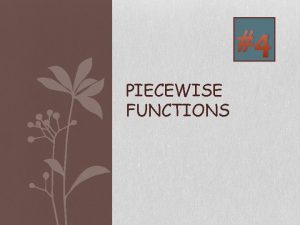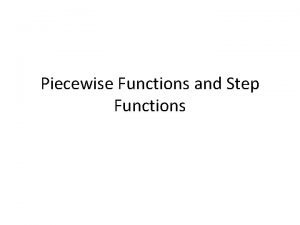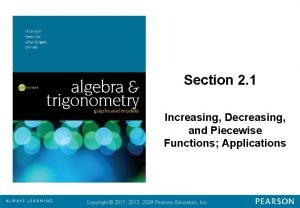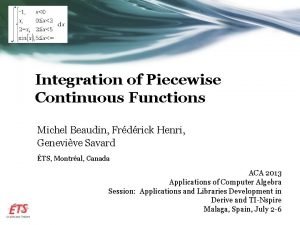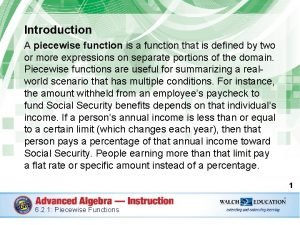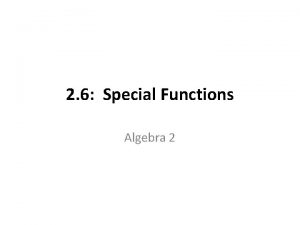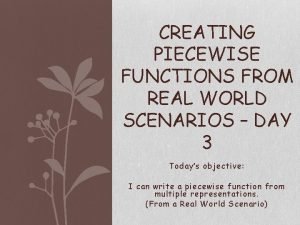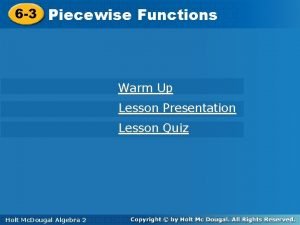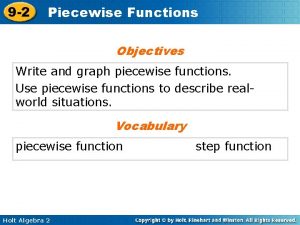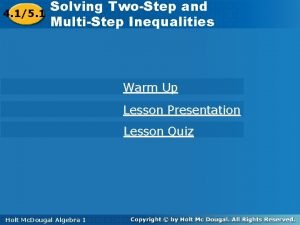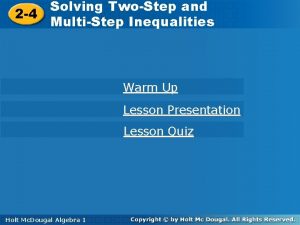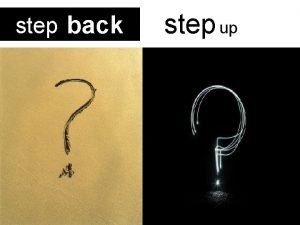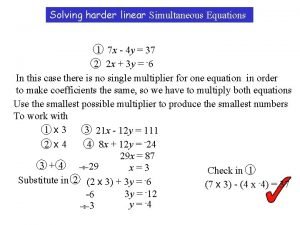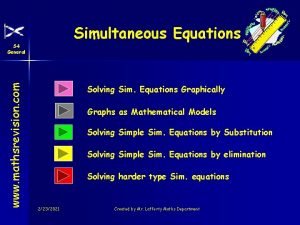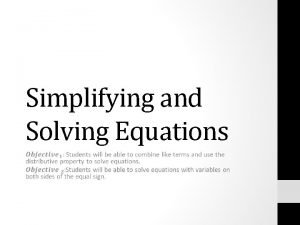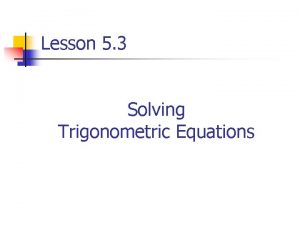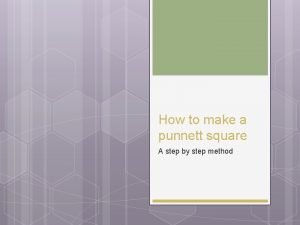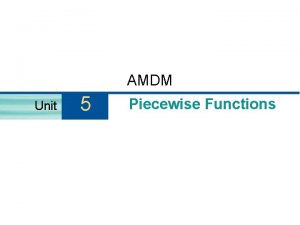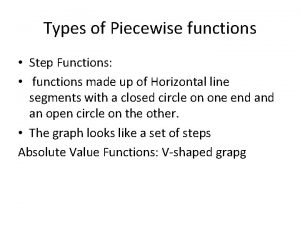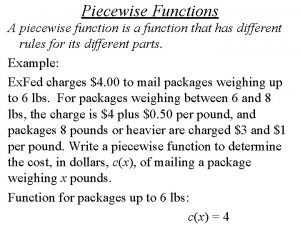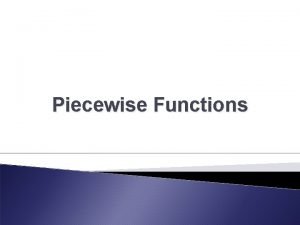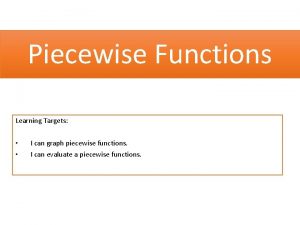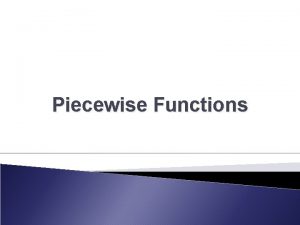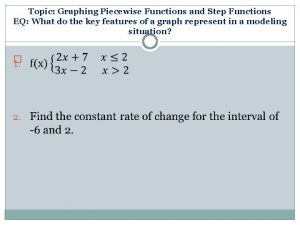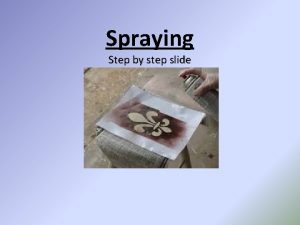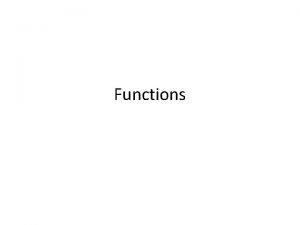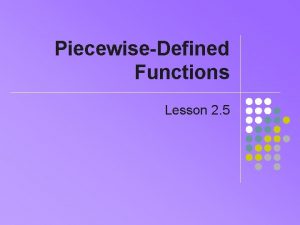Piecewise Functions and Step Functions Start at slide

































- Slides: 33

Piecewise Functions and Step Functions Start at slide # 13

I. What Are They? Up to now, we’ve been looking at functions represented by a single equation. In real life, however, functions are represented by a combination of equations, each corresponding to a part of the domain. These are called piecewise functions. Piecewise Function –a function defined by two or more functions over a specified domain.

What do they look like? f(x) = x 2 + 1 , x 0 x– 1, x 0 You can EVALUATE piecewise functions. You can GRAPH piecewise functions.

When do we use them in real life? • All the time. • Here is one example: • Admission fees. A local zoo charges admission to groups according to the following policy. Groups of fewer than 50 people are charged a rate of 35. 00 person, while groups of 50 people or more are charged a reduced rate of 30. 00 person. • This situation can be represented by a piecewise function. We will come back to this example at the end of the lesson.

II. Evaluating Piecewise Functions: Evaluating piecewise functions is just like evaluating functions that you are already familiar with. Let’s calculate f(2). f(x) = x 2 + 1 , x 0 x – 1 , x 0 You are being asked to find y when x = 2. Since 2 is 0, you will only substitute into the second part of the function. f(2) = 2 – 1 = 1

Let’s calculate f(-2). f(x) = x 2 + 1 , x 0 x – 1 , x 0 You are being asked to find y when x = -2. Since -2 is 0, you will only substitute into the first part of the function. f(-2) = (-2)2 + 1 = 5

Your turn: f(x) = 2 x + 1, x 0 2 x + 2, x 0 Evaluate the following: f(-2) = -3? f(5) = 12 ? 2? f(1) = 4? f(0) =

One more: 3 x - 2, x -2 -x , -2 x 1 x 2 – 7 x, x 1 f(x) = Evaluate the following: 2? f(3) = ? -12 ? f(-4) = -14 f(1) = -6? f(-2) =

III. Graphing Piecewise Functions: f(x) = x 2 + 1 , x 0 x – 1 , x 0 Determine the shapes of the graphs. Parabola and Line Determine the boundaries of each graph. Graph the line where Graph the parabola x is greater than or where x is less than equal to zero. Notice the closed vs open circles. Domain: Range:

Graphing Piecewise Functions: 3 x + 2, x -2 f(x) = -x , -2 x 1 x 2 – 2, x 1 Determine the shapes of the graphs. Line, Parabola Determine the boundaries of each graph.

IV. Applications • Admission fees. A local zoo charges admission to groups according to the following policy. Groups of fewer than 50 people are charged a rate of 35. 00 person, while groups of 50 people or more are charged a reduced rate of 30. 00 person. • Find a mathematical model expressing the amount a group will be charged for admission as a function of its size.


Step Functions

I. What is it? • A step function looks like a steps on a staircase. They can be represented by a piecewise function, or the greatest integer function. Try graphing the following piecewise function.


Try another:


II. Special Step Functions Two particular kinds of step functions are called ceiling functions ( f (x)= ]x[ and floor functions (f (x)=[x]). A. Ceiling Functions: In a ceiling function, all nonintegers are rounded up to the nearest integer. This is also called the ‘least integer function’. An example of a ceiling function is when a phone service company charges by the number of minutes used and always rounds up to the nearest integer of minutes.

Least Integer Function:

Least Integer Function:

Least Integer Function:

Least Integer Function:

Least Integer Function: The least integer function is also called the ceiling function. The notation for the ceiling function is: The TI-89 command for the ceiling function is ceiling (x). Don’t worry, there are not wall functions, front door functions, fireplace functions!

B. Floor Function/Greatest Integer Function In a floor function, all nonintegers are rounded down to the nearest integer. The way we usually count our age is an example of a floor function since we round our age down to the nearest year and do not add a year to our age until we have passed our birthday. The floor function is the same thing as the greatest integer function which can be written as f (x)=[x].

Greatest Integer Function:

Greatest Integer Function:

Greatest Integer Function:

Greatest Integer Function:

III. Applications of Step Functions PSYCHOLOGY One psychologist charges for counseling sessions at the rate of $85 per hour or any fraction thereof. Draw a graph that represents this situation. Understand The total charge must be a multiple of $85, so the graph will be the graph of a step function. Plan If the session is greater than 0 hours, but less than or equal to 1 hour, the cost is $85. If the time is greater than 1 hour, but less than or equal to 2 hours, then the cost is $170, and so on.

Solve Use the pattern of times and costs to make a table, where x is the number of hours of the session and C(x) is the total cost. Then draw the graph.

Answer: Check Since the psychologist rounds any fraction of an hour up to the next whole number, each segment on the graph has a circle at the left endpoint and a dot at the right endpoint.

Try this! SALES The Daily Grind charges $1. 25 per pound of meat or any fraction thereof. Draw a graph that represents this situation. A. B. C. D.

Homework • • • You are to complete #60 and #61 tonight. #60: Graphing Piecewise Functions Skip #2 #61 Step Functions WS Skip # 5
 Graphing piecewise functions
Graphing piecewise functions How to solve piecewise functions step by step
How to solve piecewise functions step by step Step 1 step 2 step 3 step 4
Step 1 step 2 step 3 step 4 Heel and toe polka dance
Heel and toe polka dance Absolute value function to piecewise function
Absolute value function to piecewise function Cosine and sine graph
Cosine and sine graph Piecewise function increasing decreasing
Piecewise function increasing decreasing Real world examples of piecewise functions
Real world examples of piecewise functions Integral of piecewise function
Integral of piecewise function Intro to piecewise functions
Intro to piecewise functions 2-6 special functions
2-6 special functions Real life piecewise function examples
Real life piecewise function examples 1-3 lesson quiz piecewise-defined functions
1-3 lesson quiz piecewise-defined functions Writing piecewise functions from a graph
Writing piecewise functions from a graph Forevers gotta start tonight
Forevers gotta start tonight Jumpstart pediatric triage
Jumpstart pediatric triage How to solve two step inequalities
How to solve two step inequalities Two step inequalities with fractions
Two step inequalities with fractions Mda technique
Mda technique Creating a dinosaur sculpture type of graphic organizer
Creating a dinosaur sculpture type of graphic organizer Whats an informative essay
Whats an informative essay Body paragraph starters
Body paragraph starters Step back step up
Step back step up Solving quadratic equations step by step
Solving quadratic equations step by step 2 systems of equations calculator
2 systems of equations calculator Simultaneous equations step by step
Simultaneous equations step by step How to combine like terms step by step
How to combine like terms step by step The process of photosynthesis step by step
The process of photosynthesis step by step Particle filter matlab code
Particle filter matlab code Oracle real application testing
Oracle real application testing Bare metal restore netbackup
Bare metal restore netbackup Lesson 5: the cosine function
Lesson 5: the cosine function Mariah carey face shape
Mariah carey face shape Bb x bb genotypic ratio
Bb x bb genotypic ratio
